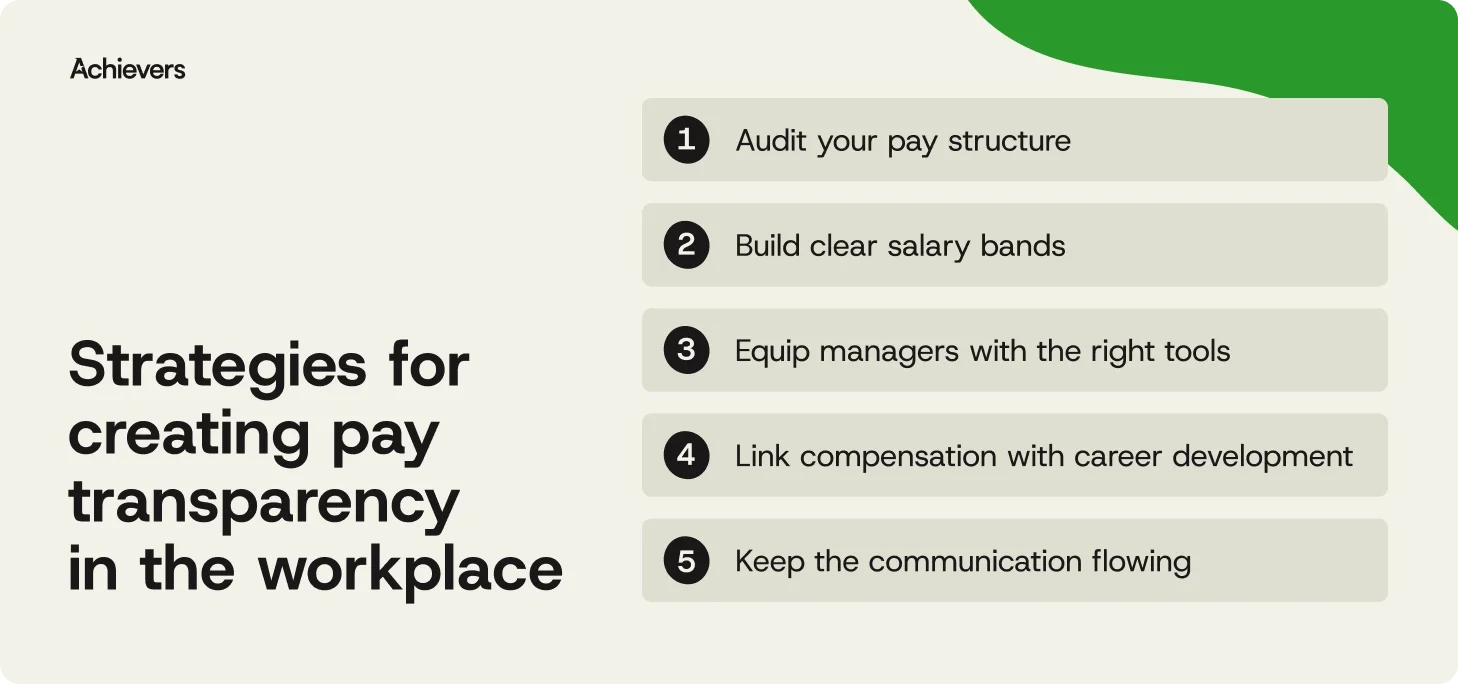Table of contents
Pay transparency used to be taboo. Now? It’s front and center. Employees want to know how pay decisions are made — and whether they’re getting a fair deal. In fact, 58% of workers told Business.com they’d choose a company that shares salary information over one that doesn’t.
Real transparency starts with numbers — but it’s sustained by trust. Companies that open up — around pay, feedback, recognition, and growth — earn something bigger: loyalty, engagement, and a culture people want to stick around for.
So, where do you start? And how do you make pay transparency more than a line item on a values page? Let’s dig into what it takes to build trust — and a stronger workplace — through transparency.
What is pay transparency?
Pay transparency is simple at its core: it’s about openness around salaries and how pay decisions are made. But not every company does it the same way. Some stick to the basics. Others go all in.
- Basic transparency: Employees get a general idea of pay ranges, but individual salaries stay private.
- Structured transparency: Salary bands and pay criteria are clearly mapped out, so employees know what to expect — and what it takes to move ahead.
- Full transparency: Everyone knows what everyone earns. It’s a bold approach that builds trust, but it demands careful planning.
Finding the right balance helps companies stay competitive and create a culture where people feel confident about their future.
Why pay transparency matters
At its heart, pay transparency builds trust — not just balances budgets. When employees understand how pay decisions are made, they feel respected, valued, and more connected to their work. It’s also a powerful driver of fairness. Transparency helps close pay gaps, strengthen retention, and build a workplace where people want to stay and grow.
Bottom line? Open conversations about pay lead to a more engaged, motivated, and loyal workforce.
Strategies for creating pay transparency in the workplace
Let’s face it: pay transparency isn’t exactly a “grab your popcorn” moment for most companies. But it’s an essential move if you want to build trust, boost morale, and prove to your employees that fairness isn’t just a buzzword, but a priority. It takes effort, but the payoff is worth it.

Here’s how to get started:
Step 1: Audit your pay structure
Before you start sharing pay details, take a hard look at where you stand. Are there any pay gaps? Is your compensation aligned with market standards and your internal equity? An audit helps you spot the areas that need a little TLC and ensures no employee is accidentally left behind. Think of it like a financial spring cleaning — no judgment, but it’s time to clear out the cobwebs.
Step 2: Build clear salary bands
Next, create salary bands that reflect roles, experience levels, and locations. Be transparent about how you set these bands, and make sure employees can easily access this information. At the same time, clarify expectations around raises, bonuses, and promotions. When people know what’s achievable and how to get there, they’re more likely to stick around (and feel motivated to hit those targets).
Step 3: Equip managers with the right tools
Managers need to be armed with more than just a vague “here’s how we do things” spiel. They should be ready for open, honest conversations about compensation. Give them the training and tools they need to navigate these discussions with confidence. It’s not just about answering questions — it’s about fostering a culture where pay transparency is seen as a perk, not a chore.
Step 4: Link compensation with career development
A big part of pay transparency is showing employees the path forward. According to Achievers’ 2024 Engagement and Retention Report, only 25% of employees say their company promotes from within for senior roles. That’s a serious opportunity missed. Make sure your salary bands are tied to performance, milestones, and career development. When employees see a clear roadmap to advancement, they’re more likely to stick around for the ride.
Step 5: Keep the communication flowing
The key to pay transparency isn’t just making an announcement and calling it a day. Keep the conversation going with regular updates through town halls, newsletters, or even casual coffee chats. Maintain an open-door policy where employees feel comfortable raising concerns and offering feedback. The more engaged they feel in the process, the more they’ll buy into the benefits of pay transparency.
Benefits and challenges of pay transparency
It’s not without challenges — but when done right, pay transparency builds trust, drives engagement, and makes your company stand out. Getting transparency right means finding the right balance, communicating clearly, and staying committed to fairness at every step.
Here’s what to know:
Benefits of pay transparency
- Building trust and fairness: Transparency levels the playing field. Employees see exactly how pay decisions are made — and what fairness looks like in practice. Sharing salary structures can help close gender and racial wage gaps, strengthening your commitment to equity. And when trust grows, so does engagement.
- Fueling engagement and morale: Clear pay structures remove doubt. When employees know where they stand — and what it takes to move ahead — motivation rises. Transparency builds a culture of recognition, momentum, and shared success.
- Attracting and keeping top talent: Fairness and trust aren’t just nice to have — they’re your edge. Job seekers are drawn to companies that are open about pay. And employees who understand how their pay is determined are less likely to leave for the unknown.
- Driving stronger business results: Trust breeds action. Engaged employees are more productive, more invested in their work, and more committed to a culture that delivers real results.
Challenges of pay transparency
- Leadership hesitation: Leaders often worry that salary transparency will create tension. But hiding information only breeds suspicion. Start small: share salary ranges, explain how decisions are made, and focus on the long-term payoff — trust, loyalty, and a stronger culture.
- Employee reactions: Learning about pay gaps — or just comparing paychecks — can be uncomfortable. Set expectations upfront. Explain how differences happen (experience, performance, skills), and commit to open, honest conversations.
- Balancing transparency with privacy: Pay transparency doesn’t mean putting everyone’s paycheck on display. Sharing ranges or bands protects privacy while still making fairness visible.
- Staying consistent: Transparency isn’t a one-time memo. It’s a mindset. Keep communication clear, consistent, and easy to understand — so no one’s left guessing where they stand.
Pay transparency: Myths vs. reality
Despite all its perks, pay transparency often gets a bad rap. The myths surrounding it can make it seem more like a hot potato than a solution. But let’s debunk some of these misconceptions, shall we? Here’s the truth behind the myths:
Myth 1: Pay transparency means revealing everyone’s salaries
Reality: Transparency isn’t about posting everyone’s salary on the company bulletin board. It’s about having clear pay structures and fair compensation frameworks in place. Employees should know how pay decisions are made, not the exact digits on each colleague’s paycheck.
Myth 2: It will create conflict among employees
Reality: Done right, transparency can actually reduce conflict. In fact, Zety’s Pay Gaps & Perceptions Report tells us that 89% of employees say knowing salary ranges for roles in their organization would improve their trust in leadership. It’s the uncertainty around pay that breeds resentment, not the clarity.
Myth 3: It limits flexibility in compensation
Reality: Transparency doesn’t mean you can’t still offer performance-based rewards or adjust compensation based on market factors. What it does mean is that employees know how decisions are made. Flexibility and fairness don’t have to be mutually exclusive.
Myth 4: Only large companies can implement pay transparency
Reality: This is one of those myths that’s flat out wrong. Companies of all sizes can benefit from pay transparency. Whether you’re a small startup or a global corporation, making compensation structures clear and accessible fosters trust and fairness — no matter your company size.
How to make sure transparency doesn’t stop at salary
If your transparency stops at salary, you’re missing the bigger picture. It’s about recognizing contributions, rewarding effort, and giving employees a real voice in shaping company culture.
Here’s how to make sure transparency doesn’t stop at the paycheck:
- Extend transparency: Don’t just stop at salary info — celebrate your employees’ achievements too. Recognizing contributions publicly shows you value people for more than just their pay — it’s about creating a culture where their impact is seen and appreciated.
- Ensure equity: A solid recognition program that’s based on actual contributions — not just compensation — helps you level the playing field. Points-based rewards, for example, can acknowledge efforts at all levels and ensure that everyone, no matter their role or background, feels valued and seen.
- Listen to employees: Keep your finger on the pulse with surveys and employee feedback tools that gauge how employees feel about recognition practices. When employees feel like they have a seat at the table, they’re more invested in the bigger picture of transparency — not just their paycheck.
Create a culture of transparency with Achievers
Salary transparency is just the beginning. Real culture change happens when transparency touches every part of the employee experience.
Achievers helps you bring that transparent culture to life. Our employee recognition software puts transparency into action with real-time recognition, personalized rewards, and continuous feedback — making sure every employee contribution is seen, celebrated, and valued.
We give HR leaders the insights they need to champion transparency across the entire employee lifecycle — from pay and recognition to career growth and beyond. Ready to turn pay transparency into lasting engagement? Learn how — with Achievers!



